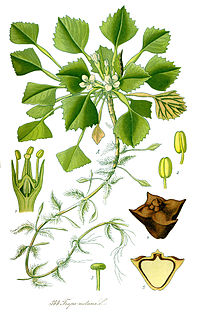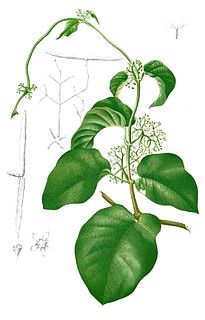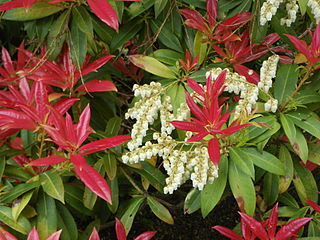
Magnolia is a large genus of about 210 flowering plant species in the subfamily Magnolioideae of the family Magnoliaceae. It is named after French botanist Pierre Magnol.

Dendrobium is a genus of mostly epiphytic and lithophytic orchids in the family Orchidaceae. It is a very large genus, containing more than 1,800 species that are found in diverse habitats throughout much of south, east and southeast Asia, including China, Japan, India, the Philippines, Indonesia, Australia, New Guinea, Vietnam and many of the islands of the Pacific. Orchids in this genus have roots that creep over the surface of trees or rocks, rarely having their roots in soil. Up to six leaves develop in a tuft at the tip of a shoot and from one to a large number of flowers are arranged along an unbranched flowering stem. Several attempts have been made to separate Dendrobium into smaller genera, but most have not been accepted by the World Checklist of Selected Plant Families.

According to APG II, the Asclepiadaceae, commonly known as milkweed family, is a former plant family now treated as a subfamily in the Apocynaceae.

Ziziphus is a genus of about 40 species of spiny shrubs and small trees in the buckthorn family, Rhamnaceae, distributed in the warm-temperate and subtropical regions throughout the world. The leaves are alternate, entire, with three prominent basal veins, and 2–7 cm (0.79–2.76 in) long; some species are deciduous, others evergreen. The flowers are small, inconspicuous yellow-green. The fruit is an edible drupe, yellow-brown, red, or black, globose or oblong, 1–5 cm (0.39–1.97 in) long, often very sweet and sugary, reminiscent of a date in texture and flavour.

Camellia sinensis is a species of evergreen shrubs or small trees in the flowering plant family Theaceae whose leaves and leaf buds are used to produce tea. Common names include "tea plant", "tea shrub", and "tea tree".

The water caltrop is any of three extant species of the genus Trapa: Trapa natans, Trapa bicornis and the endangered Trapa rossica. It is also known as buffalo nut, bat nut, devil pod, ling nut, lin kok, ling jow, ling kio nut, mustache nut or singhada.

Adrien René Franchet was a French botanist, based at the Paris Muséum national d'Histoire naturelle.

Amomum is a genus of plants native to China, the Indian subcontinent, Southeast Asia, New Guinea, and Queensland. It includes several species of cardamom, especially black cardamom. Plants of this genus are remarkable for their pungency and aromatic properties.

Endoclita is a genus of moths of the family Hepialidae. There are 60 described species found in eastern and southeast Asia and the Indian subcontinent.

Ephedra is a genus of gymnosperm shrubs, the only extant genus in its family, Ephedraceae, and order, Ephedrales. The various species of Ephedra are widespread in many lands, native to southwestern North America, southern Europe, northern Africa, southwest and central Asia, northern China and western South America.

Millettia is a genus of legume in the family Fabaceae. It consists of about 150 species, which are distributed in the tropical and subtropical regions of the world. The genus was formerly known by the name Pongamia, but that name was rejected in favor of the name Millettia, and many species have been reclassified. Due to recent interest in biofuels, Pongamia is often the generic name used when referring to Millettia pinnata, a tree being explored for producing biodiesel.

Petaurista is a genus of rodent in the family Sciuridae. They are large to very large flying squirrels found in forests and other wooded habitats in southern and eastern Asia.
Belostemma is a genus of plant in the family Apocynaceae, first described as a genus in 1834. It is native to China, India, and Nepal.
- Belostemma cordifolium(Link, Klotz. & Otto) P.T.Li - S China
- Belostemma hirsutumWall. ex Wight - Sichuan, Yunnan, India, Nepal
- Belostemma yunnanenseTsiang - Yunnan
Goniostemma is a genus of plant in family Apocynaceae, first described as a genus in 1834. It contains two known species, one native to China, the other to India and Bangladesh.
- Goniostemma acuminataWight - India, Bangladesh
- Goniostemma punctatumTsiang & P.T. Li - Yunnan

Rhododendron section Tsutsusi was a subgenus of the genus Rhododendron, commonly referred to as the evergreen azaleas. In 2005 it was reduced to a section of subgenus Azaleastrum. Containing 80 - 117 species, it includes both deciduous and evergreen types and is distributed in Japan, China and northeastern Asia. They are of high cultural importance to the Japanese. Among the species in this genus lie the largest flowering azaleas.

Heterostemma is a genus of plants in the family Apocynaceae, first described in 1834. It is native to India, China, Southeast Asia, Australia, and certain islands in the Pacific.

Orthanthera is a genus of plants in the family Apocynaceae, first described as a genus in 1834. It is native to India and Africa.
- Orthanthera albidaSchinz - Namibia
- Orthanthera butayei(De Wild.) Werderm. - Zaire
- Orthanthera gossweileriC.Norman - Angola
- Orthanthera jasminiflora(Decne.) N.E.Br. ex Schinz - South Africa
- Orthanthera strictaHiern - Angola
- Orthanthera vimineaWight - Uttar Pradesh in India
Pentasachme is a species of plants in the Apocynaceae first described as a genus in 1834. It contains only one recognized species, Pentasachme caudatum, native to southern China, the Indian Subcontinent, and Southeast Asia.

Streptocaulon is a genus of plants in the family Apocynaceae, first described as a genus in 1834. It is native to India, China and Southeast Asia.

Pieris formosa, called the Taiwan pieris or the Himalayan andromeda, is a species of flowering plant in the genus Pieris native to Nepal, the eastern Himalaya, Assam in India, Myanmar, Vietnam, Tibet, central and southern China, but not Taiwan. The 'Wakehurst' cultivar of the variety Pieris formosa var. forrestii has gained the Royal Horticultural Society's Award of Garden Merit as an ornamental, and is also considered by them as a good plant to attract pollinators. A vigorous evergreen shrub to 4 m (13 ft) in height, its leaves open red in early spring, turning green later. The trusses of creamy white flowers open at the same time as the young leaves. Like all pieris, it prefers a partially shaded spot in acid pH soil.

















